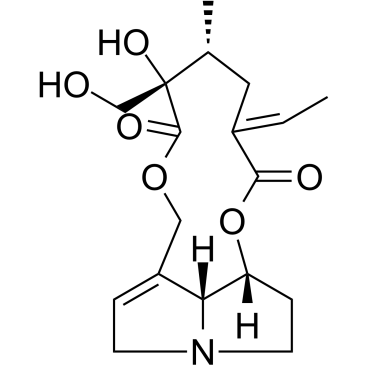Usaramine is natural product of the pyrrolizidine alkaloid class, and is isolated from seeds of Crolatalaria pallida. Usaramine demonstrates a highlighted antibiofilm activity against Staphylococcus epidermidis by reducing more than 50% of biofilm formation without killing the bacteria.
Physicochemical Properties
| Molecular Formula | C18H25NO6 |
| Molecular Weight | 351.3942 |
| Exact Mass | 351.168 |
| CAS # | 15503-87-4 |
| PubChem CID | 5281756 |
| Appearance | White to off-white solid powder |
| Density | 1.3±0.1 g/cm3 |
| Boiling Point | 583.2±50.0 °C at 760 mmHg |
| Flash Point | 306.5±30.1 °C |
| Vapour Pressure | 0.0±3.7 mmHg at 25°C |
| Index of Refraction | 1.590 |
| LogP | -0.14 |
| Hydrogen Bond Donor Count | 2 |
| Hydrogen Bond Acceptor Count | 7 |
| Rotatable Bond Count | 1 |
| Heavy Atom Count | 25 |
| Complexity | 627 |
| Defined Atom Stereocenter Count | 4 |
| SMILES | C/C=C/1\C[C@H]([C@@](C(=O)OCC2=CCN3[C@H]2[C@@H](CC3)OC1=O)(CO)O)C |
| InChi Key | BCJMNZRQJAVDLD-FXGRWVCYSA-N |
| InChi Code | InChI=1S/C18H25NO6/c1-3-12-8-11(2)18(23,10-20)17(22)24-9-13-4-6-19-7-5-14(15(13)19)25-16(12)21/h3-4,11,14-15,20,23H,5-10H2,1-2H3/b12-3+/t11-,14-,15-,18-/m1/s1 |
| Chemical Name | (1R,4E,6R,7S,17R)-4-ethylidene-7-hydroxy-7-(hydroxymethyl)-6-methyl-2,9-dioxa-14-azatricyclo[9.5.1.014,17]heptadec-11-ene-3,8-dione |
| Synonyms | Mucronatine; (15E)-Retrorsine; Usaramin; CHEBI:9912; trans-Retrorsine; (+)-Ursamine; |
| HS Tariff Code | 2934.99.9001 |
| Storage |
Powder-20°C 3 years 4°C 2 years In solvent -80°C 6 months -20°C 1 month Note: Please store this product in a sealed and protected environment (e.g. under nitrogen), avoid exposure to moisture and light. |
| Shipping Condition | Room temperature (This product is stable at ambient temperature for a few days during ordinary shipping and time spent in Customs) |
Biological Activity
| References |
[1]. Activity of pyrrolizidine alkaloids against biofilm formation and Trichomonas vaginalis. Biomed Pharmacother. 2016 Oct;83:323-329. |
| Additional Infomation |
LSM-2938 is a macrolide. Usaramine has been reported in Gynura divaricata, Crotalaria lanceolata, and other organisms with data available. |
Solubility Data
| Solubility (In Vitro) | DMSO : ~100 mg/mL (~284.58 mM) |
| Solubility (In Vivo) |
Solubility in Formulation 1: ≥ 2.5 mg/mL (7.11 mM) (saturation unknown) in 10% DMSO + 40% PEG300 + 5% Tween80 + 45% Saline (add these co-solvents sequentially from left to right, and one by one), clear solution. For example, if 1 mL of working solution is to be prepared, you can add 100 μL of 25.0 mg/mL clear DMSO stock solution to 400 μL PEG300 and mix evenly; then add 50 μL Tween-80 to the above solution and mix evenly; then add 450 μL normal saline to adjust the volume to 1 mL. Preparation of saline: Dissolve 0.9 g of sodium chloride in 100 mL ddH₂ O to obtain a clear solution. Solubility in Formulation 2: ≥ 2.5 mg/mL (7.11 mM) (saturation unknown) in 10% DMSO + 90% (20% SBE-β-CD in Saline) (add these co-solvents sequentially from left to right, and one by one), clear solution. For example, if 1 mL of working solution is to be prepared, you can add 100 μL of 25.0 mg/mL clear DMSO stock solution to 900 μL of 20% SBE-β-CD physiological saline solution and mix evenly. Preparation of 20% SBE-β-CD in Saline (4°C,1 week): Dissolve 2 g SBE-β-CD in 10 mL saline to obtain a clear solution. Solubility in Formulation 3: ≥ 2.5 mg/mL (7.11 mM) (saturation unknown) in 10% DMSO + 90% Corn Oil (add these co-solvents sequentially from left to right, and one by one), clear solution. For example, if 1 mL of working solution is to be prepared, you can add 100 μL of 25.0 mg/mL clear DMSO stock solution to 900 μL of corn oil and mix evenly. (Please use freshly prepared in vivo formulations for optimal results.) |
| Preparing Stock Solutions | 1 mg | 5 mg | 10 mg | |
| 1 mM | 2.8458 mL | 14.2292 mL | 28.4584 mL | |
| 5 mM | 0.5692 mL | 2.8458 mL | 5.6917 mL | |
| 10 mM | 0.2846 mL | 1.4229 mL | 2.8458 mL |
